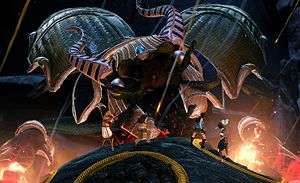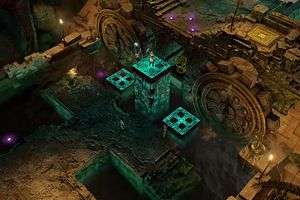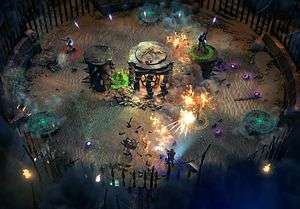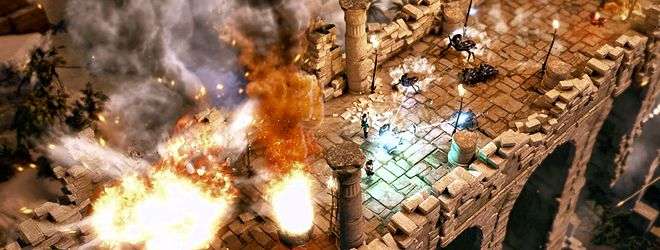Lara Croft and the Temple of Osiris – Review
by Tim
|
 More than anything, Lara Croft and the Temple of Osiris is a welcome return to the classic turquoise-tank-top-wearing, dual-pistol-wielding and less foul-mouthed heroine of the good old days, before she went all moodily post-modern for her deadly serious Lara Begins reboot. A sequel to 2010’s surprise digital hit Lara Croft and the Guardian of Light, Temple of Osiris retains the same isometric viewpoint and responsive twin-stick shooter controls, ups the player count to four, and brings back the sultry tones of Keeley Hawes who reprises her role as the titular plucky explorer. Oh old Croftie, how we’ve missed you.
More than anything, Lara Croft and the Temple of Osiris is a welcome return to the classic turquoise-tank-top-wearing, dual-pistol-wielding and less foul-mouthed heroine of the good old days, before she went all moodily post-modern for her deadly serious Lara Begins reboot. A sequel to 2010’s surprise digital hit Lara Croft and the Guardian of Light, Temple of Osiris retains the same isometric viewpoint and responsive twin-stick shooter controls, ups the player count to four, and brings back the sultry tones of Keeley Hawes who reprises her role as the titular plucky explorer. Oh old Croftie, how we’ve missed you.
If that’s not enough to get the nostalgia flowing there are also throwbacks to 1999’s The Last Revelation, as Lara and rival tomb plunderer Carter Bell unwittingly let loose the evil deity Set, the pantomime villain of the hokey piece, fixed on plunging the world into a vengeful darkness, and murderer of his own godly brother, Osiris. With the help of Horus and Isis, Osiris’s son and missus respectively, our quartet of modern-day adventurers and awakened ancient gods must overcome deadly traps, solve fiendish puzzles and, of course, raid some tombs – lovely, proper, old-fashioned tombs – to send Set packing back to the Egyptian underworld and spare the world from his dastardly intentions. It’s just another day in the life for Lady Croft, then.
Unfortunately, mini Lara’s latest never manages to surpass her previous pocket-sized adventure, the puzzles never as elaborate or as big in scale, and the action rarely as satisfying or challenging, at least in single-player that is. Make no mistake though; this is still a worthwhile adventure for any self-respecting Raider to embark on, and there are occasions where things can get pretty heated whether you’re playing solo or with friends, especially during the mostly terrific boss scraps. But most of the time it never tries to push your intellect or your trigger finger, and there’s a pervading sense that new ideas were relatively thin on the ground during development, the number of surprises disappointingly drying up fairly early on.
 For instance, the numerous albeit thrilling chase sequences are doled out far too frequently to stand out like Guardian of Light’s mad dash from a giant demon fish, enemy types are sorely lacking in variety, and puzzles are mostly alterations of standing on pressure plates. The trickier boulder-rolling and time-bomb management conundrums do impress, however, although it’s a shame there aren’t more of their creative ilk on show in the campaign, with the best puzzles consigned to the five optional Challenge Tombs spread across a central hub in which Lara and co must return the scattered pieces of Osiris found in neighbouring tombs in order to rebuild the god’s body and restore his power.
For instance, the numerous albeit thrilling chase sequences are doled out far too frequently to stand out like Guardian of Light’s mad dash from a giant demon fish, enemy types are sorely lacking in variety, and puzzles are mostly alterations of standing on pressure plates. The trickier boulder-rolling and time-bomb management conundrums do impress, however, although it’s a shame there aren’t more of their creative ilk on show in the campaign, with the best puzzles consigned to the five optional Challenge Tombs spread across a central hub in which Lara and co must return the scattered pieces of Osiris found in neighbouring tombs in order to rebuild the god’s body and restore his power.
Play in co-op and there is a noticeable improvement to the riddles, however, the game smartly shifting parts around to accommodate the increase in players, making puzzle-solving and the team work involved all the more rewarding. Gear and abilities are shared out between the group (Lara is equipped with everything in single-player, wisely avoiding the risk of incompetent AI partners), meaning communication and cooperation is often key to progression. That’s not to say there isn’t opportunity, reason or time for some treacherous tomfoolery every now and then, especially when it comes to hoovering up all the shiny gems dropped by fallen enemies or smashed free from vases. You didn’t mean to drop your buddy in that spiked pit, did you now?
 Collecting as many gems as possible is really all about the competitive score-chasing bragging rights, because the random loot system they’re tied into might as well not exist. At the end of each tomb, and placed throughout the hub, are chests which require a certain amount of gems to open – the higher the cost the better the reward. Sadly, the rewards are seldom worth the effort. Gifted with either rings or amulets, the former will buff one of your stats at the cost of another, while the latter will grant you a special perk for combat prowess. But they mostly feel ineffective, with no real reason or urge to equip one over the other. In single-player and co-op, you can easily play the entire game without ever needing any of them.
Collecting as many gems as possible is really all about the competitive score-chasing bragging rights, because the random loot system they’re tied into might as well not exist. At the end of each tomb, and placed throughout the hub, are chests which require a certain amount of gems to open – the higher the cost the better the reward. Sadly, the rewards are seldom worth the effort. Gifted with either rings or amulets, the former will buff one of your stats at the cost of another, while the latter will grant you a special perk for combat prowess. But they mostly feel ineffective, with no real reason or urge to equip one over the other. In single-player and co-op, you can easily play the entire game without ever needing any of them.
The health and ammo upgrades, in contrast, are more beneficial rewards, even if they are what bring the game’s difficulty down. While some can be found tucked away in all of the aesthetically distinct tombs, others are granted for completing optional challenges. Some relate to speed runs, some enforce conditions during specific set-pieces (don’t fall in the water, avoid catching fire, no deaths, and the like) and some involve collecting hidden red skulls. And, much like Guardian of Light, half of the fun comes from ticking them all off; the sense of satisfaction from completing all of a level’s trials and tribulations is more pleasing than collecting another fragment of Osiris’s body.
In fact, it’s this very sense of satisfaction, from raiding these old-school tombs and unearthing all their secrets, that elevates Temple of Osiris to a hearty recommendation for any Croft devotee who’s ever spent a long weekend shooting prehistoric creatures and other endangered animals, narrowly avoiding bone-crunching death and uncovering long forgotten civilisations back in Tomb Raider’s heyday. There are no utterances of the word “bastard” or serial rapists or legions of bad guys carrying guns here. This is a daft nostalgic treat that taps into what made pre-reboot Tomb Raider such a winner, even if it does fall short of Lara’s greatest adventures, her previous twin-stick co-op shooter included.
Pros- Excellent co-op
- Excellent bosses
- Excellent tombs
- Classic Lara, classic Tomb Raider
- Puzzles could be better
- Less enjoyable in single-player
- Ineffectual loot system
In single-player, Lara Croft and the Temple of Osiris is a passable action-adventure romp with mildly taxing puzzles and an endearingly hokum plot. In co-op, it becomes a far more enjoyable affair, the puzzles more intricate and the chances to mess around with your friends too good to pass up. And in both cases, it recalls the franchises earlier days before things went a bit dark and moody, and, despite the quality of the new era of Tomb Raider, the nostalgia factor alone is enough to join Lara and the gang for another Egyptian expedition. Guardian of Light remains the better of the two, but Temple of Osiris still feels like catching up with an old friend. Just make sure you bring some new ones with you to have the best time.
Last five articles by Tim
- Future Perfect
- A Thief's Alternative End
- Uncharted 4: A Thief’s End - Review
- Ratchet & Clank - Review
- Gears Of War 4 – Multiplayer Beta Impressions



























There are no comments, yet.
Why don’t you be the first? Come on, you know you want to!